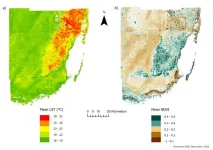(Press-News.org) Study Reveals Limits of Using Land Surface Temperature to Explain Heat Hazards in Miami-Dade County
The findings underscore the importance of further research to enhance our understanding of urban heat dynamics in subtropical and tropical regions, ensuring that heat mitigation efforts are informed by the most accurate data available.
A recent study published in the journal PLOS Climate on October 2, 2024, examines the effectiveness of using land surface temperatures (LSTs) as proxies for surface air temperatures (SATs) in subtropical, seasonally wet regions. Scientists at the University of Miami Rosenstiel School of Marine, Atmospheric, and Earth Science, used satellite remote sensing data to explore how LST reflects human heat exposure in Miami-Dade County, Florida. The findings have important implications for urban heat adaptation strategies, raising questions about how well LST captures the full extent of outdoor heat exposure in this region and beyond.
Land Surface Temperature as a Proxy for Heat Exposure
“LST data, gathered by satellite imaging, have long been used to estimate surface air temperature—the temperature people experience outdoors,” said Nkosi Muse, a Ph.D. candidate in the Abess Graduate Program in Environmental Science and Policy at the Rosenstiel School and the lead author of the study. “LSTs are a key component of lower atmosphere processes and can be studied at high resolutions—important for understanding urban heat risks and informing adaptive strategies, especially as cities grow hotter due to climate change and urban development,” he notes.
The researchers indicate the accuracy of LST as a proxy can vary based on geographical and climatic factors. While widely studied in temperate zones, the relationship between LST and SAT in subtropical regions with high summer rainfall remains less explored.
This study, focused on Miami-Dade County, aimed to bridge this gap. Using Landsat 8 remote sensing data from 2013 to 2022, researchers compared LST readings with air temperature data from local weather stations to understand when and where LST is an effective proxy for SAT. Their findings revealed seasonal variations in the relationship between LST and SAT, underscoring the complexity of using LST data in subtropical, wet regions.
Seasonal Patterns of LST and the Urban Heat Island Effect
The study found that LST data captured the spatial distribution of heat across the county, notably highlighting the presence of a surface urban heat island (SUHI) effect—where urban areas are hotter than surrounding rural areas. This effect was most pronounced during spring, with a mean SUHI intensity of 4.09°C, surprisingly higher than during the summer when it averaged 3.43°C. Notably, LST peaked in May and June, contrary to the typical northern hemisphere pattern where summer months like July and August tend to see the highest temperatures.
In contrast, SAT in Miami-Dade County reached its highest levels in August, with the relationship between LST and SAT varying significantly by season. During winter, LST closely aligned with SAT, but this connection weakened during wetter fall months. In summer months, there was no statistically significant relationship between LST and SAT.
Limitations of LST as a Heat Exposure Measure
While LST remains a useful tool for identifying spatial heat patterns in urban areas, this study suggests its limitations as a proxy for the air temperatures people experience in subtropical, seasonally wet regions like Miami-Dade. During the wet season, LST may underestimate the actual heat exposure residents face. The timing of LST data collection (11 AM ET/12 PM EST) might also play a role, as this snapshot does not capture the peak heat of the day, especially during humid, rainy months.
“These findings highlight the risks of relying solely on LST for urban heat adaptation strategies, especially in climates that do not follow temperate patterns,” said Amy Clement, a professor of atmospheric sciences at the Rosenstiel School and a co-author of the study. “As cities around the world, particularly in subtropical and tropical regions, face increasing threats from heatwaves and rising temperatures, these results emphasize the need for more precise measurements to accurately assess heat risks and inform responses,” she says.
Implications for Urban Planning and Future Research
The study’s findings have immediate relevance for urban planners and policymakers working on heat adaptation strategies in subtropical and tropical regions. As Miami-Dade County continues to develop new heat policy and the City of Miami unveils its first ever “Heat Season Plan,” these findings can be incorporated into further planning. The findings suggest that relying on LST alone may lead to a misrepresentation of heat risks, particularly during the wet season, when air temperatures can be significantly higher than surface temperatures.
As urban areas face growing pressure to protect at-risk populations from extreme heat, this research points to the need for more sophisticated approaches to measuring and mitigating heat exposure in Miami-Dade. Using LST data to identify neighborhoods most at risk from heat may overlook the intensity of heat exposure in some areas, particularly during the hottest months of the year. This could result in inadequate or misdirected heat adaptation strategies.
The study also opens avenues for future research, particularly in exploring how localized processes—such as vegetation, water bodies, or urban materials—affect surface energy balances and LST readings. Understanding these factors could improve the accuracy of LST as a tool for measuring heat exposure in diverse urban environments.
About the University of Miami and Rosenstiel School of Marine, Atmospheric and Earth Science
The University of Miami is a private research university and academic health system with a distinct geographic capacity to connect institutions, individuals, and ideas across the hemisphere and around the world. The University’s vibrant and diverse academic community comprises 12 schools and colleges serving more than 19,000 undergraduate and graduate students in more than 180 majors and programs. Located within one of the most dynamic and multicultural cities in the world, the University is building new bridges across geographic, cultural, and intellectual borders, bringing a passion for scholarly excellence, a spirit of innovation, a respect for including and elevating diverse voices, and a commitment to tackling the challenges facing our world. With more than $413 million in research and sponsored program expenditures annually, the University of Miami is a member of the prestigious Association of American Universities (AAU).
Founded in 1943, the Rosenstiel School of Marine, Atmospheric, and Earth Science is one of the world’s premier research institutions in the continental United States. The school’s basic and applied research programs seek to improve understanding and prediction of Earth’s geological, oceanic, and atmospheric systems by focusing on four key pillars:
*Saving lives through better forecasting of extreme weather and seismic events.
*Feeding the world by developing sustainable wild fisheries and aquaculture programs.
*Unlocking ocean secrets through research on climate, weather, energy and medicine.
*Preserving marine species, including endangered sharks and other fish, as well as protecting and restoring threatened coral reefs.
www.earth.miami.edu.
END
Study reveals limits of using land surface temperature to explain heat hazards in Miami-Dade County
The findings underscore the importance of further research to enhance our understanding of urban heat dynamics in subtropical and tropical regions, ensuring that heat mitigation efforts are informed by the most accurate data available.
2024-10-02
ELSE PRESS RELEASES FROM THIS DATE:
The Lancet Public Health: Accelerating actions to eliminate tobacco smoking could help increase life expectancy and prevent millions of premature deaths by 2050, modelling study suggests
2024-10-02
First in-depth forecasts of future worldwide health impacts of smoking reveal potential effects of eliminating smoking on life expectancy and premature deaths by 2050.
Based on current trends, global smoking rates could continue to decrease to 21.1% in males and 4.18% in females by 2050.
Analysis indicates accelerating actions towards the elimination of smoking globally would increase life expectancy and prevent millions of premature deaths, resulting in 876 million fewer years of life lost (YLLs).
Reducing smoking rates to 5% by 2050 would increase life expectancy by one year among males and 0.2 years among females ...
The Lancet Public Health: Banning tobacco sales among young people could prevent 1.2 million lung cancer deaths, global modelling study suggests
2024-10-02
Analysis of the impact on lung cancer deaths of banning tobacco sales in people born between 2006 and 2010 indicates 1.2 million deaths could be avoided.
The findings suggest the creation of a tobacco-free generation could prevent almost half (45.8%) of future lung cancer deaths in men, and around one-third (30.9%) in women, in this birth cohort.
Nearly two-thirds (65.1%) of the deaths averted would be in low- and middle-income countries (LMICs). Close to two-thirds (61.1%) of all lung cancer deaths in high-income countries would be avoided.
Creating a generation of people who never smoke could prevent 1.2 million deaths from lung cancer globally, according ...
One million people who never regularly smoked now vape in England
2024-10-02
The number of adults vaping in England who have never regularly smoked has increased sharply since 2021, when disposable e-cigarettes first became popular, according to a new study by UCL researchers.
The study, published in Lancet Public Health and funded by Cancer Research UK, estimated that, as of April 2024, about one million adults who had never regularly smoked now vaped in England, a sevenfold increase since 2021, with most of them vaping daily and over a sustained period.
This increase was largely driven by young adults, ...
Methane emissions from dairy farms higher than thought - but conversion could reduce emissions
2024-10-02
New research has found methane emissions from slurry stores on dairy farms may be up to five times greater than official statistics suggest - and highlights the huge potential for turning them into a renewable energy source.
The study shows that if captured and turned into biogas, emitted methane could be worth more than £400m a year to the dairy sector in saved fuel costs, or around £52,500 for an average-sized dairy farm.
Capture technology already exists, and if rolled out across the EU dairy herd, the conversion of methane to biofuel could reduce emissions equivalent to an estimated 5.8% of the ...
Early foster care gave poor women power, 17th-century records reveal
2024-10-02
UNDER STRICT EMBARGO UNTIL 00:01 AM (UK TIME) ON THURSDAY 3RD OCTOBER 2024
A rare collection of 300-year-old petitions gives voice to the forgotten women who cared for England’s most vulnerable children while battling their local authorities.
‘Confirm the said yearly annuity or otherwise the child is very like to be famished & starved’
– Ellen Fell (1665)
'Taking pity of them for fear they should be starved to death for want of food [I] did table & receive the said three Children' - Anne Beesley (1671)
Today, the UK faces a major retention ...
Unpacking polar sea ice
2024-10-02
Polar sea ice is ever-changing. It shrinks, expands, moves, breaks apart, reforms in response to changing seasons, and rapid climate change. It is far from a homogenous layer of frozen water on the ocean’s surface, but rather a dynamic mix of water and ice, as well as minute pockets of air and brine encased in the ice.
New research led by University of Utah mathematicians and climate scientists is generating fresh models for understanding two critical processes in the sea ice system that have profound influences on global climate: the flux of heat through sea ice, thermally linking the ocean and atmosphere, and the dynamics of the ...
U of M Medical School receives $3.2M to study drivers of chronic low back pain
2024-10-02
MINNEAPOLIS/ST. PAUL (10/2/2024) — The University of Minnesota Medical School recently received a five-year, $3.2 million R01 grant from the National Institute of Arthritis and Musculoskeletal and Skin Diseases for a project that will study the epigenetic factors of low back pain. Low back pain affects 619 million people globally and is the single leading cause of disability worldwide, according to the World Health Organization. This chronic pain impacts people of all ages and can affect quality of life and mental well-being.
Epigenetics refers to biological processes that affect how genes work without altering the DNA itself. These changes can ...
UT Health San Antonio School of Nursing’s Caring for the Caregiver program earns national award
2024-10-02
SAN ANTONIO, Oct. 2, 2024 – The Caring for the Caregiver Program (C4CP) of the School of Nursing at The University of Texas Health Science Center at San Antonio (UT Health San Antonio) has earned a national award for its comprehensive education and support for families living with dementia.
The 5TH Annual Maude’s Awards were announced in Seattle, rewarding innovations that enrich the quality of life for persons living with Alzheimer’s disease and related dementias, as well as their care partners. The award was created in 2019 by Richard Ferry, co-founder of management consulting firm Korn Ferry International, ...
People infer the past better than the future, study finds
2024-10-02
If you started watching a movie from the middle without knowing its plot, you’d likely be better at inferring what had happened earlier than predicting what will happen next, according to a new Dartmouth-led study published in Nature Communications.
Prior research has found that humans are usually equally good at guessing about the unknown past and future. However, those studies have relied on very simple sequences of numbers, images, or shapes, rather than on more realistic scenarios.
"Events in real life have complex associations relating to time that haven't typically been captured in past work, so we wanted to explore how people make inferences ...
Sexual and gender minorities more likely to experience life dissatisfaction, isolation, stress
2024-10-02
FOR IMMEDIATE RELEASE
Wednesday, October 2, 2024
Contact:
Jillian McKoy, jpmckoy@bu.edu
Michael Saunders, msaunder@bu.edu
##
Sexual and Gender Minorities More Likely to Experience Life Dissatisfaction, Isolation, Stress
A new study found that sexual and gender minority adults in the US were more likely to report multiple social risk factors than heterosexual and cisgender adults, highlighting the need for policies that advance the health and socioeconomic well-being of these groups.
Until last year, few national surveys collected information about the prevalence of social risk factors—individual-level adverse experiences such as food insecurity ...
LAST 30 PRESS RELEASES:
Pusan National University researchers discover faster, smarter heat treatment for lightweight magnesium metals
China’s 2024 Gastroenterology Report: marked progress in endoscopy quality and disease management
Pusan National University researchers uncover scalable method for ultrahigh-resolution quantum dot displays
Researchers use robotics to find potential new antibiotic among hundreds of metal complexes
Gut bacteria changes at the earliest stages of inflammatory bowel disease
Scientists develop new way to “listen in” on the brain’s hidden language
Brain research: “Pulse generators” grow and shrink as memories are formed
For teens, any cannabis use may have impact on emotional health, academic performance
School meals could unlock major gains for human and planetary health
Menopause hormone therapy does not appear to impact dementia risk
Signature patterns of brain activity may help predict recovery from traumatic brain injury
Dresden study uncovers new key mechanism in cancer cells
New species are now being discovered faster than ever before, study suggests
Cannabis-based products show limited short-term benefit for chronic pain, with increased risk of adverse effects
Cannabis products with more THC slightly reduce pain but cause more side effects
Clearing the brain of aging cells could aid epilepsy and reduce seizures
Brain injuries linked with potential risk of suicide, new study finds
New technique lights up where drugs go in the body, cell by cell
New study finds movement of fishing fleets can reveal shifts in marine ecosystems
Embargoed: New evidence points to potential treatment for vascular dementia
Study uncovers disrupted brain balance in alcohol dependence
Working in groups can help Republicans and Democrats agree on controversial content moderation online
Structural findings reveal how distinct GPCR ligands create different levels of activation
Anything-goes “anyons” may be at the root of surprising quantum experiments
UC review: Maximizing workplace opportunity for veterans
From generation to complex control: Metasurfaces make perfect vortex beams "within reach"
Thin-film lithium niobate-based detector: recent advances and perspectives
Exploring why some people may tend to persistently make bad choices
How cells balance their protein levels
Nirsevimab vs RSVpreF vaccine for RSV–related hospitalization in newborns
[Press-News.org] Study reveals limits of using land surface temperature to explain heat hazards in Miami-Dade CountyThe findings underscore the importance of further research to enhance our understanding of urban heat dynamics in subtropical and tropical regions, ensuring that heat mitigation efforts are informed by the most accurate data available.



